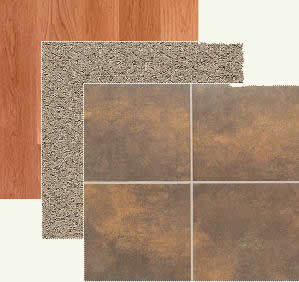
Figure 1 - Flooring materials
The Romans and Greeks, used fired clay tiles on the ground going farther back than 1,000 BC. The advent of fired flooring material allowed the floors to be properly cleaned for the first time in history. The Egyptians used natural stone, such as granite as a flooring material, and slate was used in other parts of Europe to cover the earth. In Persia, they wove animal hair into wool to create rugs and in other parts of the world, complete animal skins were used to provide flooring comfort.
A lot has changed since cavemen used straw as a flooring material.
Additional information on flooring materials, styles and installation.
Today we have a vast assortment of materials available for making and covering our floors to provide us with comfort and aesthetic warmth:
- Wooden planks and boards (more than 50 varieties)
- Bamboo (which is a grass)
- Cork
- Ceramic Tile
- Porcelain Tile
- Clay - tiles and bricks
- Laminate flooring (a manmade manufactured product)
- Natural Stone – in slabs and tiles
- Glass (produced in blocks)
- Vinyl – in sheets and tiles
- Carpet – in square yards or as tiles.
- Rugs & Mats – in natural and manmade fiber
- Concrete - stained and painted
- Leather
Slate;
And, each of the above coverings comes in a vast assortment of textures, colors, patterns, shapes, thicknesses, and sizes.
However, it is not only the aesthetic value that must be considered when purchasing flooring as each material has advantages and disadvantages pertaining to wear, installation, maintenance, cleaning, longevity, thermal properties, moisture properties, and price.
In many cases, it is advantageous to use combinations of flooring, such as placing area rugs over wood, ceramic, porcelain, or naturals stone floors. The combination can create a unique appearance as well as adding comfort to the room.
If you are considering changing your flooring, you should take some time to consider all the possibilities and options that you have available.
